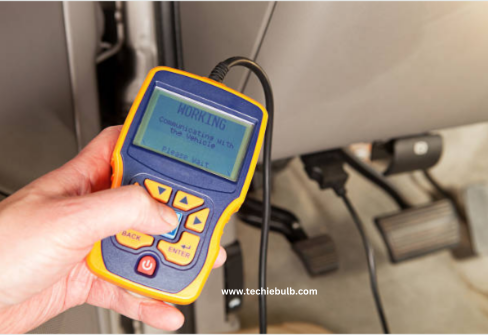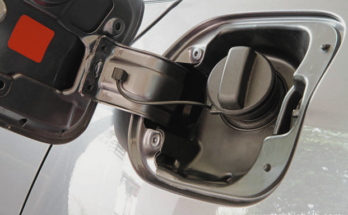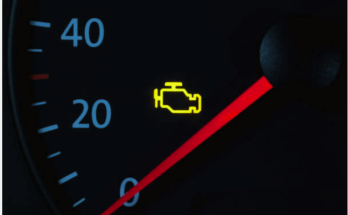If you’ve ever had the check engine light pop up on your Nissan vehicle, chances are you’ve encountered those dreaded diagnostic trouble codes (DTCs). Among the several codes, one that may raise concern is the P1273 code.
But fear not, our article will cover all the aspects of what this code means and how to tackle it effectively.
The P1273 code specifically pertains to Nissan vehicles and relates to an issue with the Air Fuel Ratio (A/F) Sensor 1 on Bank 1. This sensor plays a crucial role in monitoring the air-fuel mixture in the engine, ensuring optimal combustion and emission control.
When this code appears, it signals that there’s a problem with the sensor itself, its wiring, or its connectors.
Understanding the underlying causes of the Nissan P1273 code is the first step in resolving it. Whether it’s a faulty sensor, damaged wiring, or poor connections, diagnosing the issue accurately is vital.
In our comprehensive guide, we’ll explore the common triggers for this code and outline practical solutions to address them effectively.
Stay tuned as we unravel the mysteries behind the P1273 code, empowering you with the knowledge to tackle engine issues head-on and keep your Nissan running smoothly.
Code:P1273 Code Description: Air Fuel Ratio Sensor 1 Bank 1 Lean Shift Monitoring
When is the Code P1273 Detected?

The P1273 trouble code is typically detected by the onboard diagnostic system of a Nissan vehicle when there is an issue with the Air Fuel Ratio (A/F) Sensor 1 on Bank 1.
This sensor is continuously monitored by the engine control module (ECM) for proper functioning and to ensure the optimal air-fuel mixture within the engine.
The P1273 code is triggered when the ECM receives abnormal or out-of-range signals from the A/F sensor, indicating a problem with its operation or the air-fuel ratio in the engine.
This could be due to various factors such as a malfunctioning sensor, damaged wiring, exhaust system leaks, or engine mechanical issues affecting the air-fuel mixture.
Once the ECM detects the discrepancy in the A/F sensor readings, it illuminates the check engine light on the vehicle’s dashboard and stores the P1273 trouble code in its memory.
This serves as an indication to the vehicle owner or technician that there is a problem with the air-fuel ratio system that needs to be addressed.
It’s important to note that the P1273 code may not always result in noticeable symptoms, especially in the early stages. However, ignoring the code can lead to reduced engine performance, decreased fuel efficiency, and increased emissions over time.
What are the Possible Causes of the DTC Code P1273 Nissan?
The DTC P1273 in Nissan vehicles can be triggered by various underlying issues. Here are some possible causes to consider:
Faulty Air Fuel Ratio (A/F) Sensor: The primary cause of the P1273 code is often a malfunctioning A/F sensor. Over time, these sensors can wear out or become contaminated, leading to inaccurate readings and triggering the code.
Wiring Issues: Damaged or corroded wiring connected to the A/F sensor can disrupt the signal transmission, causing erroneous readings and prompting the P1273 code.
Poor Electrical Connections: Loose or poor electrical connections between the A/F sensor and the engine control module (ECM) can result in intermittent signal loss, leading to the activation of the P1273 code.
Exhaust System Leaks: Any leaks in the exhaust system, such as cracks or holes in the exhaust manifold or exhaust pipes, can introduce extra oxygen into the exhaust stream, affecting the A/F sensor’s readings and triggering the code.
Engine Mechanical Problems: Issues such as vacuum leaks, intake manifold leaks, or problems with the fuel injectors can disrupt the air-fuel mixture and lead to the activation of the P1273 code.
ECM Malfunction: In rare cases, a malfunction or software glitch in the engine control module (ECM) can erroneously trigger the P1273 code.
What are Code P1273 Possible Symptoms?
Experiencing the P1273 trouble code in your vehicle can manifest through various symptoms, indicating underlying issues with the air-fuel ratio system. Here are some common symptoms associated with the P1273 code:
Check Engine Light: The most obvious symptom is the illumination of the check engine light on the vehicle’s dashboard. This light typically comes on when the onboard diagnostic system detects a problem, such as the P1273 code.
Decreased Fuel Efficiency: A malfunctioning air-fuel ratio sensor can lead to improper fuel mixture, resulting in decreased fuel efficiency. You may notice that your vehicle is using more fuel than usual to travel the same distance.
Engine Performance Issues: The engine may exhibit performance issues such as hesitation, rough idling, or stalling. This can be caused by the improper air-fuel mixture affecting combustion and engine operation.
Poor Acceleration: A faulty air-fuel ratio sensor can lead to poor acceleration response, causing the vehicle to feel sluggish or unresponsive when accelerating.
Increased Emissions: An incorrect air-fuel mixture can lead to increased emissions from the vehicle, potentially causing it to fail emissions tests.
Rough Running: The engine may run rough or unevenly due to the improper combustion caused by the incorrect air-fuel ratio.
If you notice any of these symptoms or if the check engine light comes on, it’s essential to have your vehicle diagnosed by a qualified mechanic to determine the exact cause of the P1273 trouble code and address any underlying issues promptly.
Delaying repairs can lead to further damage and potentially more costly repairs down the line.
How to Fix the Code P1273 Nissan?

Fixing the P1273 trouble code in a Nissan vehicle involves addressing the underlying issues that trigger the code. Here’s a step-by-step guide on how to effectively resolve the P1273 code:
Diagnostic Scan: Start by using an OBD-II scanner to retrieve the specific trouble codes stored in the vehicle’s onboard computer. Verify that the P1273 code is present and take note of any additional codes for a comprehensive diagnosis.
Inspect A/F Sensor: Check the condition of the Air Fuel Ratio (A/F) sensor, particularly Sensor 1 on Bank 1, as it is directly associated with the P1273 code.
Look for signs of damage, contamination, or wear. If the sensor appears faulty, it may need to be replaced.
Check Wiring and Connections: Inspect the wiring harness connected to the A/F sensor for any signs of damage, corrosion, or looseness. Repair or replace any damaged wiring as necessary.
Ensure that all electrical connections are secure and free of corrosion, as poor connections can cause the P1273 code to recur.
Address Exhaust Leaks: If there are any leaks in the exhaust system, such as cracks or holes in the exhaust manifold or pipes, they need to be repaired promptly.
Exhaust leaks can introduce additional oxygen into the exhaust stream, leading to erroneous readings by the A/F sensor and triggering the P1273 code.
Resolve Engine Mechanical Issues: Address any underlying mechanical issues within the engine, such as vacuum leaks, intake manifold leaks, or problems with fuel injectors.
These issues can disrupt the air-fuel mixture balance, contributing to the activation of the P1273 code.
Verify ECM Functionality: While rare, a malfunctioning engine control module (ECM) can also trigger the P1273 code.
Perform diagnostic tests to ensure that the ECM is functioning correctly and accurately interpreting sensor data. If necessary, reflash or replace the ECM.
Clear Codes and Test Drive: Once the repairs have been completed, use the OBD-II scanner to clear the trouble codes from the vehicle’s memory. Take the vehicle for a test drive to ensure that the P1273 code does not reappear and that the engine operates smoothly.
Routine Maintenance: To prevent the recurrence of the P1273 code, follow a regular maintenance schedule for your Nissan vehicle.
This includes periodic inspections of the A/F sensor, wiring, and exhaust system, as well as addressing any emerging issues promptly.
By following these steps and thoroughly addressing the underlying causes of the P1273 code, you can effectively fix the issue and ensure the continued performance and reliability of your Nissan vehicle.
If you’re unsure about any aspect of the diagnosis or repair process, consult with a qualified automotive technician for assistance.
What is the Cost for Code P1273 diagnostic?
The cost for diagnosing the P1273 trouble code in a Nissan vehicle can vary depending on several factors:
Diagnostic Fee: Many auto repair shops charge a diagnostic fee to connect a scan tool to the vehicle’s onboard diagnostic port and retrieve the trouble codes stored in the engine control module (ECM).
This fee typically ranges from $50 to $150, depending on the shop’s labor rates and location.
Labor Costs: Once the P1273 code is retrieved, the technician will need to perform further diagnostic tests to pinpoint the exact cause of the issue. This may involve visually inspecting the A/F sensor, checking the wiring and connectors, conducting tests on the exhaust system, and possibly performing other diagnostic procedures.
Labor rates vary widely depending on the shop’s hourly rate, but you can expect to pay anywhere from $80 to $150 per hour for diagnostic labor.
Parts Replacement: If the cause of the P1273 code is determined to be a faulty A/F sensor, damaged wiring, or other components requiring replacement, you’ll need to factor in the cost of parts.
The price of these parts can vary depending on the vehicle’s make and model, as well as the quality of the parts being used.
For example, an A/F sensor for a Nissan vehicle can cost anywhere from $100 to $300, while wiring harnesses or other components may range in price from $50 to $200 or more.
Additional Repairs: In some cases, diagnosing and repairing the P1273 code may uncover other issues that need to be addressed simultaneously.
For example, if exhaust system leaks are discovered during the diagnostic process, you may need to budget for the cost of repairing or replacing those components as well.
Conclusion
Understanding and addressing the P1273 diagnostic trouble code in Nissan vehicles is crucial for maintaining engine performance and emissions control. By recognizing the common causes of the code, such as faulty A/F sensors, wiring issues, exhaust leaks, or engine mechanical problems, vehicle owners can take proactive steps to diagnose and resolve the issue promptly. Through careful inspection, proper repairs, and thorough testing, the P1273 code can be effectively addressed, ensuring that the engine operates smoothly and efficiently




